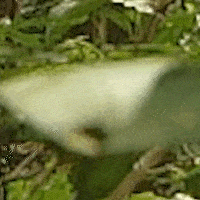Nature is not Green
Video Installation , 2021

Video installation composed of two projections 4 x 7 meters. 11 hours
NAM Manifattura Tabacchi- SUPERBLAST- Firenze, 2021.
NAM Manifattura Tabacchi- SUPERBLAST- Firenze, 2021.
* * *
“In Nature Is Not Green, the visitor is immersed in an environment that appears cohesive but which, over time, reveals its discordant contrasts. We view two landscapes remotely: the installation juxtaposes these two environments situated at opposite ends of our Planet as they are recorded in
real time, during the longest day of the year. The Amazon forest in Brazil is a paradigm of a nature that is still primordial, violent and wild, whereas one of the several cultivated forests in Holland, is the prototype of nature designed to represent a tamed, classic ideal, suffused in an aura of safety and serenity. Ironically, these two landscapes are united by a common destiny as they fall prey to the capitalist practices of resource extraction and tree recycling, which are dictated by similar economic aims. This work reveals a speculative financial strategy and it spurs awareness about the remnants of a colonial treatment of nature and its resources. Biopower and its dominion over nature are expressed by the control over its image. This work by Bermudez Obregon shows a dichotomy between phenomenon and thing, image and its origin, and investigates the living possibilities of the boundary that separates them.”
Caterina Taurelli Salimbeni , Curator
“In Nature Is Not Green, the visitor is immersed in an environment that appears cohesive but which, over time, reveals its discordant contrasts. We view two landscapes remotely: the installation juxtaposes these two environments situated at opposite ends of our Planet as they are recorded in real time, during the longest day of the year. The Amazon forest in Brazil is a paradigm of a nature that is still primordial, violent and wild, whereas one of the several cultivated forests in Holland, is the prototype of nature designed to represent a tamed, classic ideal, suffused in an aura of safety and serenity. Ironically, these two landscapes are united by a common destiny as they fall prey to the capitalist practices of resource extraction and tree recycling, which are dictated by similar economic aims. This work reveals a speculative financial strategy and it spurs awareness about the remnants of a colonial treatment of nature and its resources. Biopower and its dominion over nature are expressed by the control over its image. This work by Bermudez Obregon shows a dichotomy between phenomenon and thing, image and its origin, and investigates the living possibilities of the boundary that separates them.”
Caterina Taurelli Salimbeni , Curator
















Many
European nations find
ecological
comfort in projects of reforestation, re-wilding, bio-politics, and
eco-friendly legislation within their own borders, but there is a
common negligence and voluntary
abandonment towards nature in the ex-colonies and in general, towards the
global south.
In
2015 The
Royal Dutch Shell PLC oil and gas company extracted
daily near
to 20.000 barrels (1.5M
worth) of crude from
The Amazon forest, almost
20% of the total 230.293
barrels extracted daily from that geographical
place. The presence of
this company on amazonian land goes back to the 1930’s, a town
called Shell was founded in
the Ecuatrian Amazon
back then, and billions
of barrels of crude
have been extracted
since.
Companies
like
Shell,
responsible
for a high percentage of global carbon emissions, tend to make
significant investments in projects to reduce their carbon footprint.
For example, The Royal
Shell is today the
main private
financier of Staatsbosbeheer reforestation
program in The Netherlands. The
Shell
affirms
to
have secured
the plantation of 5 millions trees inside The Netherlands border.
In The Netherlands there is no untouched nature, there is no entropy left. Every landscape is voluntarily created and designed following an accepted image of what nature should look like. Policy determines the appearance of nature, and the image to reproduce is one of a primeval closed forest, and that is what is planted as ornament of human dwellings.
The
Amazon forest in
this case, seems to be
a
sequestered
landscape,
and besides that,
re-wilding
projects
in Europe, like
the ones being developed in The Netherlands by the Staatsbosbeheer,if
isolated, are
no
different from gardening projects enclosed
by high fences. They
are
no different
to
Assyrian hunting parks,
which were
just
enclosed
park-sized gardens built to recreate wilderness, and make a spectacle
out of the king hunting his “wild” preys.
In any event, both of these natural landscapes, are now connected by political or economical reasons. 5 Million trees in Dutch forests owe their existence to almost one hundred years of continuous devastation in The Amazon.
These
two landscapes will have a conversation. In this time of virtuality and remote presentness,
it
is possible to
bring
this two
places together into the same space. Let’s have the
ancient rainforest of the Amazon and the young European woods have a
zoom call and work this out together.




